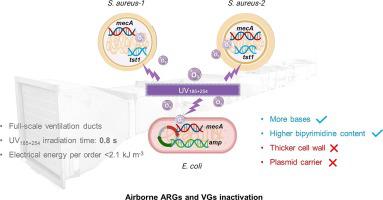当前位置:
X-MOL 学术
›
Chem. Eng. J.
›
论文详情
Our official English website, www.x-mol.net, welcomes your feedback! (Note: you will need to create a separate account there.)
Rapid inactivation of antibiotic resistance genes and virulence genes in the building ventilation duct by UV185+254 irradiation
Chemical Engineering Journal ( IF 15.1 ) Pub Date : 2024-03-24 , DOI: 10.1016/j.cej.2024.150635 Yankai Xie , Xiaojing Zhu , Pengyi Zhang , Shan Wang
Chemical Engineering Journal ( IF 15.1 ) Pub Date : 2024-03-24 , DOI: 10.1016/j.cej.2024.150635 Yankai Xie , Xiaojing Zhu , Pengyi Zhang , Shan Wang

|
The energy-efficient inactivation of airborne antibiotic resistance genes (ARGs) and virulence genes was seldom investigated in full-scale ventilation systems. This study examined the potential of UV disinfection to inactivate two types of chromosome- or plasmid-encoded ARGs ( and ) and one chromosomal virulence gene () within two host bacterial species: and . UV disinfection exhibited dual damages (i.e., physical by 254 nm UV and oxidative by the produced ozone) on those target genes, resulting in relatively strong adaptability to temperature and low electrical energy per order in specific gene removal (down to 1 kJ m). It was found that the disinfection efficiency of target genes was up to 2 orders of magnitude lower than that of the host bacteria. The target genes with more bases and higher weighted bipyrimidine content were more susceptible to UV treatment. Thicker cell walls and plasmid carriers prominently hindered UV deactivation, requiring larger radiation power to enhance the gene removal efficiency in bioaerosols.
中文翻译:

UV185+254照射快速灭活建筑通风管道内抗生素抗性基因和毒力基因
空气传播抗生素抗性基因(ARG)和毒力基因的节能灭活很少在全面通风系统中进行研究。这项研究检验了紫外线消毒灭活两种宿主细菌物种中两种类型的染色体或质粒编码的 ARG ( 和 ) 以及一种染色体毒力基因 ( ) 的潜力: 和 。紫外线消毒对这些目标基因表现出双重损伤(即254 nm紫外线的物理作用和产生的臭氧的氧化作用),导致其对温度的适应性较强,并且在特定基因去除中每阶电能较低(低至1 kJ m)。结果发现,目标基因的消毒效率比宿主细菌低多达2个数量级。具有更多碱基和更高权重联嘧啶含量的靶基因更容易受到紫外线处理。较厚的细胞壁和质粒载体显着阻碍了紫外线灭活,需要更大的辐射功率来提高生物气溶胶中的基因去除效率。
更新日期:2024-03-24
中文翻译:

UV185+254照射快速灭活建筑通风管道内抗生素抗性基因和毒力基因
空气传播抗生素抗性基因(ARG)和毒力基因的节能灭活很少在全面通风系统中进行研究。这项研究检验了紫外线消毒灭活两种宿主细菌物种中两种类型的染色体或质粒编码的 ARG ( 和 ) 以及一种染色体毒力基因 ( ) 的潜力: 和 。紫外线消毒对这些目标基因表现出双重损伤(即254 nm紫外线的物理作用和产生的臭氧的氧化作用),导致其对温度的适应性较强,并且在特定基因去除中每阶电能较低(低至1 kJ m)。结果发现,目标基因的消毒效率比宿主细菌低多达2个数量级。具有更多碱基和更高权重联嘧啶含量的靶基因更容易受到紫外线处理。较厚的细胞壁和质粒载体显着阻碍了紫外线灭活,需要更大的辐射功率来提高生物气溶胶中的基因去除效率。



























 京公网安备 11010802027423号
京公网安备 11010802027423号